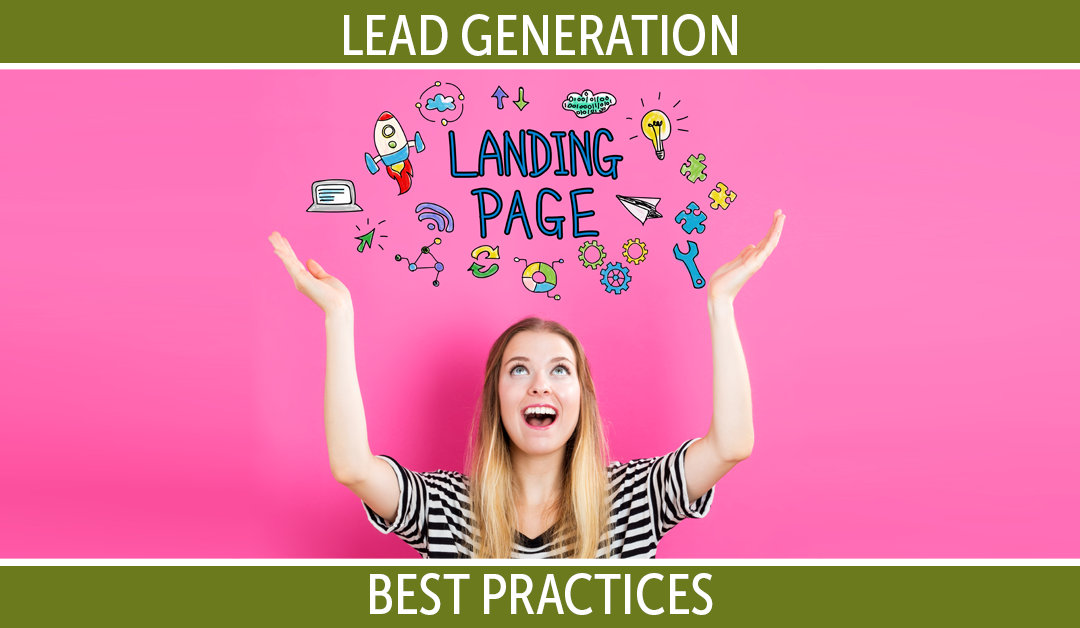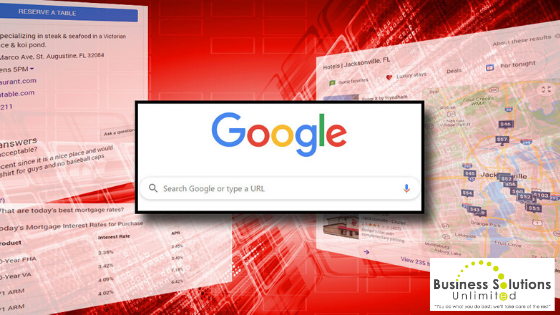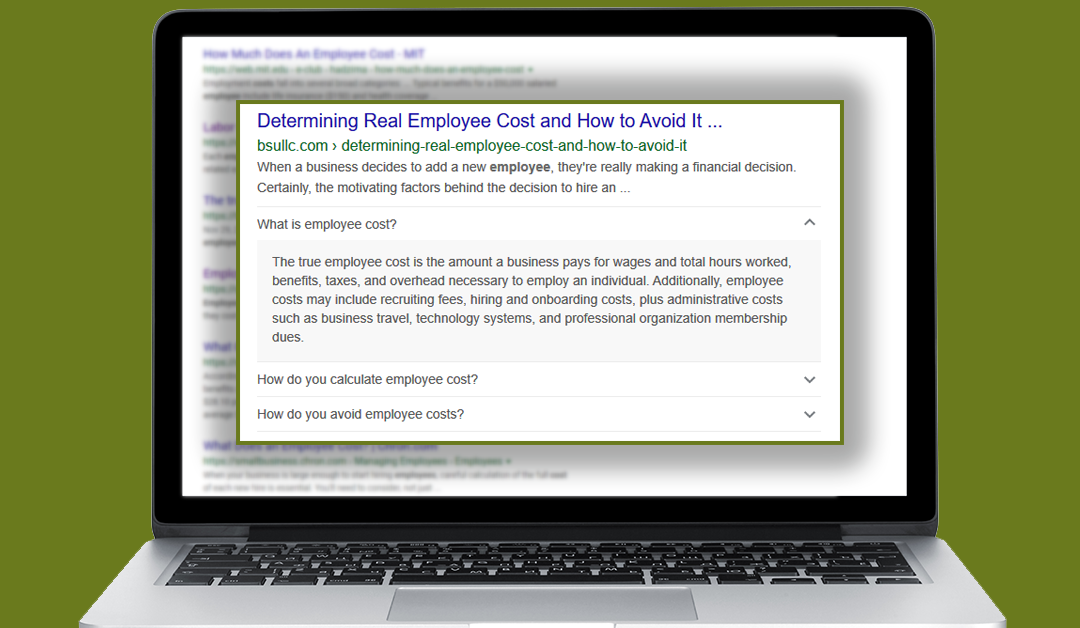
by admin
In 2020, successful small businesses will be optimizing their Google My Business listing to increase their visibility, attract more customers, and push aside local competitors.
In recent years, Google has optimized its search page to help its searchers find what they need without clicking to a website. Today, more than 64% of customers have used Google My Business listings to find a business address, phone number, information, and directions.
Businesses that have optimized their online presence for Google’s Zero-click searches are well-positioned to get more customers.
One way to stand out with your Google My Business listing is simply to add more photos.
We’ll share details about this optimization tactic below.
However, if you’re thinking “wow, another task I’ve got to add to my busy day!” we’d like to come to your rescue.
Delegate That Task to Business Solutions Unlimited
Business Solutions Unlimited can help you to optimize your Google My Business listing plus make sure your online presence truly reflects the benefits customers gain by choosing your business.
Give us a call at (904) 429-4588 and let us get started helping you today.
How More Google My Business Photos May Make a Difference in Your Business
In the last half of 2019, research conducted by BrightLocal uncovered compelling data that the quantity of photos on a Google My Business listing may make a significant difference in the behaviors of online searchers and Google’s search results.
When compared with average business listings, the research found that businesses with more than 100 images got:
- 520% more calls
- 2,717% more direction requests
- 1,065% more website clicks
The research also found correlating data that a business listing with more than 100 images gets 713% more discovery searches in Google than the average business listing.
According to Google, a discovery search occurs when a customer searches a category, product, or service that you offer and your listing appears.
How in the World Do You Get More than 100 Photos for Your Google My Business Listing?
While adding 100 photos to your Google My Business listing may seem like a herculean task, the research shows it may have a significant impact on your business.
Google already suggests that businesses add the following photos to their Google My Business listing:
- 3 exterior photos
- 3 interior photos
- 3 product photos
- 3 work-related photos
- 3 food & drink photos if relevant
- 1 common area photo
- 3 room photos if a hotel or vacation rental
- 3 team photos
With a little effort, you can add the number of photos to that list:
- Restaurants can add food and drink photos from their entire menu
- Vacation rentals can add more rooms, unique views, special room features, etc.
- Service-oriented businesses can add photos of projects completed at a customer’s home
- Attorneys could hold monthly educational events and take photos of attending participants (with their permission)
Also, encourage customers to take and post photos for you. Offer a free appetizer on a return visit if a customer posts photos of their dinner at a restaurant. Consider creating a picturesque spot where customers can take selfies.
From adding photos to adding FAQs, Google is making Google My Business a comprehensive and robust business center for local searches.
For 2020, we recommend that businesses make optimizing their Google My Business listing a priority.
Do You Have Time to Optimize Your Google My Business Listing?
If you don’t, we do.
That’s why we’re here.
Give Business Solutions Unlimited a call at (904) 429-4588 to explore ways we can help your business today.
Frequently Asked Questions About Google My Business Photos
What are the requirements for photos uploaded to Google My Business listings?
Google requires the following standards for your photos to look their best in your Google My Business listing:
- Format: JPG or PNG
- Size: Between 10 KB to 5 MB
- Minimum Resolution: 720 px tall x 720 px wide
- Quality: Photos should represent the reality of your business and be focused and well lit. Photos should have no significant alterations or excessive use of filters.
What criteria does Google have for photos uploaded to Google My Business listings?
Google asks that photos uploaded to Google My Business listings be relevant to the business and its location. Basically, they want actual photos of your products, services, staff, and locations to help searchers have a realistic view of your business. They state that the use of stock imagery is not relevant and may be removed.
Can you have text or a logo on photos uploaded to Google My Business listings?
Google states that text or graphics superimposed on photos uploaded to Google My Business listing be relevant to the business. Text and graphics cannot take up more than 10% of the image.

by admin
How would you like to increase the online presence of your business with a free webpage?
Yes, that’s a free webpage to showcase your branding, message, products, and services—all courtesy of Google.
Launched in 2017, Google’s Website Builder provides businesses that have a Google My Business (GMB) listing an opportunity to create a single page webpage in three simple steps:
- Create: Business details and images automatically pulled from your GMB listing
- Edit: Customize your page with themes, colors, and content
- Publish: With or without a custom domain name
Google walks you through each step and many businesses could publish their free website within 10 minutes.
Look below for additional information on Google’s Website Builder and how your business could use it to increase your online presence.
However, if you’re thinking “wow, another task I’ve got to add to my busy day!” we’d like to come to your rescue.
Business Solutions Unlimited can help create not just your GMB webpage, but make sure your online presence truly reflects the benefits customers gain by choosing your business.
Give us a call at (904) 429-4588 and let’s see how we can help your business today.
Frequently Asked Questions and Details About Google’s Website Builder
What Types of Businesses Could Benefit from a Google My Business Website
Any business with a Google My Business listing can use Google’s Website Builder and should do so. Why? Well, it’s free. It’s also provided by Google, which gives it a bit of an online boost for your online presence.
Google is constantly looking for details about your business to present to searchers and this webpage would add to your overall online presence.
Can a Google Website Replace a Business’ Stand-alone Website?
Since Google’s Website is a single page, it would be a challenge for most businesses to use to fully communicate your business’s details.
Savvy businesses consider their website as a hub of online presence and will use Google’s free webpage as a component in their overall online presence.
Businesses can provide links to their stand-alone website on Google’s webpage.
What Content Can Be Put on a Google Website?
A Google My Business website is divided into zones of content and pulls much of it from a business’s GMB listing. The site is divided into:
- Navigation
- Header: Business name and description
- Banner Image
- Updates from GMB posts
- Testimonials pulled from the GMB listing
- About Us: A summary of your business, products, and services
- Gallery of Images: Pulled from GMB
- Contact Info: Map, Contact Number, Address, Hours, etc.
Can a Google Website be Mobile Friendly?
Google My Business website is optimized for mobile. In fact, you can manage the site straight from your phone.
Do You Have Time to Optimize Your Google My Business Listing?
If you don’t, we do.
That’s why we’re here.
Give Business Solutions Unlimited a call at (904) 429-4588 to explore the ways we can help you with your business today.

by admin
If you have a business website, lead generation would probably be its most important objective.
Google released its Lead Gen UX Playbook in 2019 filled with best practices on how to create a successful lead generation page that will motivate your visitors to take action.
Below are several takeaways from the playbook that you could use not just for a lead generation page, but throughout your website.
Make Your Call to Action Descriptive
For a business, the call to action (CTA) is the most important element on your webpage. After all, the ultimate purpose of your business website is to initiate some type of action.
Google suggests avoiding making generic CTAs. Instead, make your CTAs descriptive by stating precisely what the user should expect. Make your CTAs beneficial.
Instead of “Learn More”, or “Call Now”, try
- Learn More About ‘this topic’
- Get Started with Your Free Subscription
- Call Now for More Information About…
Benefits of Descriptive CTAs According to Google:
- Links will be more accessible
- Links will be more enticing to users and potentially more persuasive
- Users will feel more confident as they click from page to page
- More keywords on the page will help search-engine optimization
- Meaningful links will stand out and help users who are scanning the page
Communicate a Clear Value Proposition
This starts with a clearly stated headline that swiftly communicates to the viewer how your product, service, or information can solve their problem. The key is to get the viewer of your webpage to quickly understand the value of the content on your page.
Once they see value on your page, they’re more likely to take the next step as described in your CTA.
Gain Trust Through Social Proof
Psychologically, some form of validation may be instrumental for your website viewers before they make a decision to take action on your CTA. To quote the Google playbook:
“Social proof is a psychological phenomenon where people reference the behavior of others to guide their own behavior”
Social proof can be communicated through a variety of methods, including:
- Testimonials
- Number of people using services and products
- User ratings
Follow Google’s Guidance on Webpage Design Best Practices
Google includes several design best practices in their playbook. They include:
Remove automatic carousels: Basically, viewers will ignore image and content carousels on websites.
Don’t use full-page interstitials: Interstitials are used to cover webpage content the viewer was expecting with other content, such as a promotion. Usually, viewers must click to move past the interstitials. When viewers encounter these, they typically will hit the back button.
Use legible font sizes: Readability throughout a website site should be the goal for every business. The ideal font size for the main body text is 16 px.
The Google Lead Gen Playbook has many best practice tips and research on making a successful lead generation landing page. We suggest you take a moment to look through the document and see what you can use to increase conversion on your landing pages.
Do You Have Time to Implement these Best Practices?
If you don’t, we do. That’s why we’re here.
Give Business Solutions Unlimited a call at (904) 429-4588 and let’s see how we can help your business today.
Lead Generation Landing Page Frequently Asked Questions (FAQ)
Below are FAQs about online searches.
What is a lead generation landing page?
Lead generation landing pages typically are focused on one value proposition with the intent on capturing visitor’s information through the lead contact form or phone call.
What is a CTA?
CTA is an acronym for call to action. On a website, commercial or printed advertisement, the CTA helps to convert the viewer to take a desired action such as a phone call or click.
What is a value proposition?
A value proposition presents the benefit of your product, services, or information. It communicates what problem your business can solve for a client. Value propositions can be a key element that separates your business from competitors.
What are examples of social proof that can help increase credibility on a website?
Social proof can help guide people’s behaviors when making a decision to purchase from or contact a business through a website. Examples of social proof may include testimonials, the number of people using services and products, and user ratings.

by admin
It’s starting to look like an optimized Google My Business profile may be just as important to local businesses as their website.
Nearly half of Google searches resulted in zero clicks. That means searchers (your potential customers) found the information they were looking for straight from Google’s search results.
Less than half of Google searches resulted in an organic click to non-Google-owned websites. These searchers proceeded to click-thru to a website—hopefully yours.
Those were findings based on data provided by a marketing analytics firm, Jumpstart, earlier in 2019.
Here are the stats for searcher clicks that are creating a buzz among marketers and businesses:
- Zero-Click Searches: 48.96%
- Organic Clicks to Non-Google Sites: 41.45%
- Organic Clicks to Google Sites: 5.90%
- Paid Clicks to Google Sites: 0.11%
- Paid Clicks to Non-Google Sites: 3.58%
What are Google Sites?
A while back, that would be Google properties like Youtube.
Now, Google serves up a variety of search result options that can impact businesses in the travel, hotel, flights, shopping, and food delivery fields. That list will continue to grow over time.
Where are those Zero-Click Searchers Going?
Google has been on a mission to provide searchers with as much value as possible in the search results.
When a searcher requests information on a local business, Google likes to serve up the following on their results page:
- Your business phone number plus a click to call button
- A way to send a message to your business
- Ability to ask a question about your business
- Ability to read or posts reviews
- Your menu if you’re a restaurant
- Your special offers and prices
Not too long ago, your potential customers would have to visit your website to find this information.
Now, Google is showing this information from businesses that have provided this information through their Google My Business profile or markups on their websites.
Smart businesses understand that a high-performance Google My Business profile can increase their online visibility in both searches and maps.
More visibility means more customers and revenue.
So, Are Websites Necessary?
They sure are.
As the stats above show, there are still considerable clicks to non-Google sites.
Additionally, Google and other search engines will consistently crawl your site seeking answers to searcher questions and queries.
Businesses can make it easier for Google to gather this information by providing Schema markups on their websites.
Schema markup provides structured data that search engines use to show searchers facts and particulars about topics they’re searching.
There are thousands of schema markups that can be built into websites. Businesses can use markups to share:
- Business info such as hours, location, etc.
- Restaurant menus
- Events
- Products and pricing
- Articles
Providing Schema markups on your website is a good way to make your site the hub of your online presence.
Do You Have Time to Manage Your Online Presence?
If you don’t, we do. That’s why we’re here.
Give Business Solutions Unlimited a call at (904) 429-4588; so we can start helping you today.
Online Search Frequently Asked Questions (FAQ)
Below are FAQs about online searches.
What is a Zero-Click Search?
Zero-click searches generally occur when a search engine result page displays the answer a searcher is seeking. When the search result page satisfies the searcher’s intent, there is no need for further clicks.
What is Schema Markup Code?
Schema markup is code placed on websites that helps search engines understand the data presented on webpages. This helps search engines provide informative data for their users.

by admin
How would you like to take up more real estate on Google’s search results page? Would you like to increase the discoverability of your website on Google Assistant devices?
You can by simply adding FAQPage Structured Data markup to your webpages.
In May 2019, Google rolled out a FAQPage Structured Data feature that businesses can use on their websites. The feature increases opportunities for businesses to feature helpful webpage content on Google Search result pages.
In many cases, websites implementing the structured data markup have dominated search results on specific topics.
By increasing the real estate on search result pages to display FAQs, these websites will have essentially crowded out competitors.
Additionally, displaying the FAQs online strengthens the perception of business’ knowledge on the specific topic and their helpfulness on their services. This would be an invaluable step toward establishing your expertise and authority in your industry.
Google Guidelines on FAQPage
Google provides guidance on how businesses may use FAQPage Schema on their website.
Basically, Google requests using the markup when your page has a list of questions and answers.
It’s important to note that the Q&As have to be visible on the page.
Valid uses for the markup can be a product, services, or topics page that lists FAQs.
Invalid uses of the markup include:
- A product page where visitors can actively submit questions
- Advertising purposes
- Content that may be considered obscene, profane, sexually explicit, graphically violent, promotion of illegal or dangerous activities, hurtful or harassing language
It’s also important to note that Google does not guarantee that this content will be made available on their search result page:
Disclaimer: Google does not guarantee that your structured data will show up in search results, even if your page is marked up correctly. To determine whether a result gets a rich treatment, Google algorithms use a variety of additional signals to make sure that users see rich results when their content best serves the user’s needs.
Potential Uses of this FAQPage Feature?
Business Solutions Unlimited has started using this feature on webpages focused on knowledge-based topics. Recently, we used it on a blog post about determining employee costs.
We’re also using the markup on this webpage. We see this feature as an opportunity to provide helpful information for searchers and increase our online presence on search pages. Additionally, by displaying this content online, it will help increase our reputation as subject matter experts.
Below, we’ve brainstormed how some businesses might be able to use this feature.
How Could a Restaurant Use this FAQ Feature?
Without being promotional, restaurants could provide FAQs on a variety of topics. For example, they could answer the following questions on their menu page about gluten-free meals, sources for their ingredients, special food preparation techniques, and seasonal dishes. On their general page, they could include information on seating, notable history of the restaurant, whether they take reservations, etc.
How Could an Attorney Use this FAQ Feature?
Attorney websites could be a treasure trove for FAQs topics. Questions and answers could be provided on the firm’s specialties. Answers could be provided on education topics such as specific criminal law and family law topics.
How Could a Vacation Rental Business Use this FAQ Feature?
FAQs displayed on the search page could answer many questions a potential renter might have. Topics for Questions and Answers might include the size of the property, how many people can be accommodated, distance to specific notable locations (beach, downtown, etc.)
At the moment, not many businesses have implemented this feature on their webpages.
As stated above, we believe this is a wonderful opportunity for businesses to use this new feature to further promote their expertise plus increase their visibility online.
Don’t Have Time to Learn About and Implement this Feature on Your Website?
We understand that many business owners might consider implementing FAQPage Markup on their page just one more task to add to their busy day. That’s where we can help.
Give Business Solutions Unlimited a call at (904) 429-4588 and let us start helping you and your business today.
FAQPage Structured Data Frequently Asked Questions (FAQ)
Below are FAQs about FAQPage Structured Data.
What are Frequently Asked Questions (FAQs)?
Frequently Asked Questions (FAQs) are questions and answers to a specific topic. A website may include a FAQ page for visitors to gain answers to questions about the company or individual behind the website, details on products and services provided by the business or individual. Webpages dedicated to specific topics, products, or services may also include FAQs on the subject matter.
What is FAQPage Structured Data?
FAQPage Structured Data is Schema.org markup used by website content creators to help show what is considered rich results on Google’s search page. Google allows markups to be built by using JSON-LD or Microdata on webpages. Markup FAQ content may be eligible for a collapsible menu under search engine results on specific topics. When clicked, the menu reveals the answer. This markup can be a powerful tool for businesses to use to help increase their online presence and strengthen their reputation on search pages.
How Many FAQs can be displayed on search result pages using FAQPage Structured Data?
Currently, three FAQs are actively displayed on search result pages. A provided link allows the searcher to uncover up to seven more FAQs on the search result page.
How is FAQPage Structured Data used with Google Assistant?
Google uses structured data to provide content for voice-oriented Google Assistant devices. This provides an opportunity for businesses to increase their presence on multiple devices beyond basic web searches.

by admin
This summer, Google announced new features businesses may use to enhance their Google My Business (GMB) listing.
According to Google, the new GMB features will help businesses “make their profiles as unique as they are and as descriptive as the queries that get customers there.”
Let’s take a look at these new features.
Give Welcome Offers to First Time Customers
Businesses can reward customers who follow their online presence with an offer or discount. According to Google, more than half of online customers look for an offer or discount.
Create a Short Name for Your Google My Business Presence
Have you ever looked at your GMB URL? It’s usually a bunch of numbers and letters—nothing you’d want to add to a business card or email. Plus, it’s not very memorable.
Now business owners can claim an easily remembered unique short name for their GMB presence. Businesses will be able to change their short name up to three times a year.
Very soon, these short names will be searchable on Google.
Specify Your Business GMB Cover Image
Business owners can now set their preferred cover image for their GMB presence.
Give More Presence to Business Logos
For businesses with completed GMB profiles, Google will give prominence to their logo in the upper right-hand of their GMB box.
More Prominence for Photos
Google will add a new dynamic module to GMB profiles to display photos uploaded by businesses.
Very soon, businesses will be able to add photo captions to their photos.
Rewarding Business with “Local Favorite” Designation
Google also announced a forthcoming “Local Favorite” designation. The top 5 percent of businesses that show consistent and great customer experiences will be highlighted in the “Local Favorite” category.
Why it’s Time to Get Your Google My Business Profile Up to Speed
These new features show Google’s commitment to making branded search results a final destination to customer searches.
As we mentioned in our recent article Why You Should Audit Your Google My Business Presence:
In recent years, Google has not-so-quietly been staging a bit of a takeover on the Web. Not content to be the largest search engine in the world, Google is actively working toward a “zero-click-query” environment.
Basically, Google wants to serve up answers to searcher queries—without sending them to a website. Google wants to keep users on Google.
To stay competitive in local online search, businesses should take full advantage of the features available on GMB. Doing so will help the business develop and maintain a robust online presence that’s not solely dependent on a website for converting searchers to clients.
Don’t Have Time to Manage Your Google My Business Profile?
Many business owners might look at their GMB profile as just more tasks to add to their busy schedules. However, to stay relevant with local searches, they’re necessary tasks to aid in the future success of your business.
That’s why we’re here. Give Business Solutions Unlimited a call at (904) 429-4588 and let us get to work for your business today.
Page 1 of 812345...»Last » 





